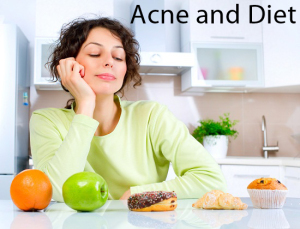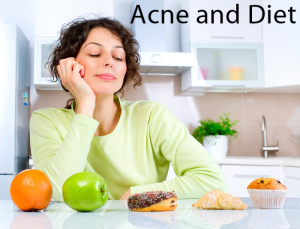Diet And Acne – What Your Doctor Isn’t Telling You

Acne is caused by a combination of the skin producing too much sebum and a build-up of dead skin cells which clog the pores and leads to a localized infection or spot. It is thought that excess sebum production is caused by hormonal fluctuations, which explains why around 80% of teenagers experience bouts of acne throughout adolescence. While there is no danger from the spots themselves, severe acne can scar as well as lead to anxiety, low self-esteem and depression.
For ages there’s been an exception to ‘you are what you eat’ saying- ‘Acne’. Doctors scoff at the idea and the web is littered with diet acne myth articles. But is it really so?
A landmark overview of research carried out over the past 50 years has found that eating foods with a high glycaemic load (GL) and dairy products not only aggravated acne, but in some cases triggered it, too.
Current diet-acne scenario
• A positive correlation exists between consumption of dairy products and acne. A 2005 analysis titled “High school dietary dairy intake and teenage acne explored the possible associations between dairy-related foods and the incidence of physician-diagnosed acne. In an analysis of more than 47,000 teens, a positive correlation was found between acne and the intake of milk. The study noted that there was no difference seen between full-fat versus low-fat milk intakes in relation to breakouts. In other words, regardless of the type of cow’s milk, acne was still seen prevalently in the participants’ skin.
A similar analysis study conducted in 2006 titled “Milk consumption and acne in ` adolescent girls reviewed the affects of dairy on visible breakouts in young women from 9–15 years of age. Researchers concluded that greater consumption of milk was associated with higher prevalence of acne.”
Both studies also pointed to the hypothesis that the association with milk may be because of the presence of hormones and bioactive molecules, as well as its effect through the insulin like growth factor (IGF-1) pathway. Through these pathways, dairy intake may aggravate acne on a number of levels, including an increase in oil production, inflammation and abnormal hormonal activity.
2. A low-glycemic load diet has a positive correlation in the reduction of acne.
Regular consumption of high-glycemic load foods elevates insulin levels and may, in turn, stimulate sebum production and sebaceous cell prolifer¬ation. It concluded that the improvement in acne and insulin sensitivity after a low-glycemic load diet suggests that nutrition-related lifestyle factors may play a role in the pathogenesis of acne. This includes whole foods, such as fruits, greens, vegetables, brown rice and nuts.
3. Fruits and vegetables may help minimize signs of acne.
Rural cultures with diets high in fruits, nuts and root vegetables have been observed to have a very minimal incidence of acne. Studies point to whole foods, such as fruits and vegetables, as having a positive correlation with clear skin. This makes sense: Plants are, by and large, some of the strongest anti-inflammatory food sources available. By increasing daily intake of fruits, greens and vegetables, clients biologically increase their immunity and could potentially decrease signs of acne.
Choosing low Glycemic load (GL) foods
- Only carbohydrates have a GL rating.
- Because the body takes longer time to break lower GL foods hence they help you feel fuller for longer too.
- High GL foods include sugary fizzy drinks, cakes, pastries, chocolate, white bread, potatoes etc.
- Low GL foods include fruit and vegetables, wholegrain options such as brown pasta, brown rice, pulses etc.
- Not overcooking your pasta and vegetables helps lower the GI.
Encourage and educate
Physicians are often first in line to work with clients suffering from acne. With the subject of diet and skin care becoming more mainstream, it is important that those working in the skin care community arm themselves with the information and know-how to advice clients about such matters.
• Keep a binder of studies in the waiting area. Allow clients easy access to such information, perhaps even highlighting important areas of note.
• Inform clients that research shows a positive correlation between high glycemic load diet/ dairy consumption and acne.
• Encourage healthy eating by suggesting an increase of more fruits, greens and vegetables. On average, a person eat less than two servings of fruits and vegetables a day, which is far below the minimum daily recommended serving size of 5–13. Plant-based foods are some of the richest anti-inflammatory resources available. An increase in these foods may decrease visible signs of inflammatory skin disorders, such as acne.
By bringing to light the diet-acne connection, the wheels start turning for clients to consider how their food choices affect their skin. It is important for skin care professionals to be at the forefront of emerging research and understand the nutritional connections to skin health. Providing sound and honest advice about skin care is crucial to enriching your individual practice. The more you are able to share with your clients, the deeper your relationships with them will grow.
Bibliography:
1. CA Adebamowo, et al, High school dietary dairy intake and teenage acne, J Am Acad Dermatol 52 2 207–214 (Feb 2005)
2. CA Adebamowo, et al, Milk consumption and acne in adolescent girls, Dermatol Online J 12 4 1 (May 2006)
3. RN Smith, et al, A low-glycemic-load diet improves symptoms in acne vulgaris patients: a randomized controlled trial, Am J Clin Nutr 86 1 107–115 (Jul 2007)
4. ML Nagpal, et al, Human chorionic gonadotropin up-regulates insulin-like growth factor-I receptor gene expression of Leydig cells, Endocrinology 129 6 2820–2826 (Dec 1991)
5. L Cordain, et al, Acne vulgaris: a disease of Western civilization, Arch Dermatol 138 12 1584–1590 (Dec 2002
6. http://howtostoyno.altervista.org/diet-and-acne/ (Accessed April 30 , 2015)
7. O Schaefer, When the Eskimo Comes to Town, Nutrition Today 6 6 8–16 (Nov/Dec 1971)
